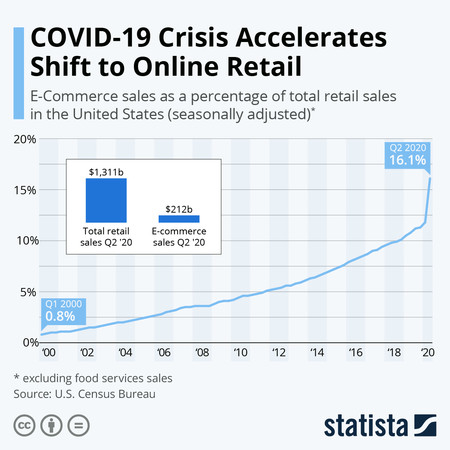

How Retail has Changed—From Black Friday 2020 and Beyond
COVID-19 has changed the way we shop. While many of us were already buying online, many were also paying a visit to their local stores. Once the pandemic hit and physical stores closed or otherwise became a risky play, online shopping exploded. By some estimates, it has reached a level many experts predicted wouldn’t occur for five to 10 more years.
With the pandemic in full swing and the holidays ahead, marketers need to ensure their ecommerce approach is dialed in and meeting the needs of today’s changing consumer. Here’s what you need to know to succeed.
Consumer shopping behaviors have changed for good

Old habits are hard to break, but now that consumers have had the better part of a year to form new online shopping routines, conventional wisdom suggests that finding and buying what you need online is more common for all age groups. Suddenly, it was not only convenient, but it was also the safer option. We almost “had” to start shopping online to stay safe while buying the products we needed. In the same way that grandparents adopted new technologies, like Zoom, in order to see their grandkids, an entire swath of traditional shoppers decided that going into stores just wasn’t worth the risk – especially for commodity items.
Now that consumers understand the simplicity behind buying online, research shows that many plan to stick with it. According to SalesForce, 68% of all U.S. consumers plan to continue buying essential goods online even once the pandemic subsides (73% of Gen Z and Millennials, 69% of Gen X and 57% of Baby Boomers). Previously, Baby Boomers have been reluctant to shop online. Now, 45% say they are shopping online more, according to the National Retail Federation (NRF).
Retailers are flexing to meet increased demand online
Retailers, too, are adjusting to accommodate increasing virtual visitors and decreasing in-store visitors. Many retailers, if not most, had already been working to bring their ecommerce platforms up-to-date purely from the perspective of having to compete with Amazon. However, beyond the binary choice of in-store and online, they’re finding that they need to offer a variety of options to accommodate shopper preferences and safety.
Since the beginning of COVID-19, we’ve heard about “flattening the curve.” While that applied largely to infection and hospitalization rates, there is a similar need for a flattening of the shopping curve. Due to the continuation of the pandemic, retailers and shoppers want to avoid huge surges of traffic, such as those that occur on Black Friday. As a result, the upcoming holiday shopping season has started much earlier than in recent years, which should produce less of a glut of shoppers during the typical busy season as shoppers space out purchases or choose from several fulfillment options:
- In-store purchases – We’re talking good, old-fashioned, instant gratification, in-store shopping.
- At-home delivery – If you can wait, it makes the whole process as easy as possible because you never have to step foot outside.
- Curbside pickup – The best of both worlds: order online to make sure you don’t forget anything and avoid impulse buys, get contactless pickup, avoid the frustrations of the interior of the store (out of stocks, checkout lines, other people) and get your items quickly if not the same day. This is also perhaps the best option for gift-givers who want to avoid having any potential surprise ruined by an ill-timed package delivery.
Retailers (and retail apps such as Instacart and goPuff) have worked hard to develop multiple channels to enable customers to make purchases in whichever way they feel safest.
Holiday shoppers are starting earlier than ever
So, how will this newfound interest in online shopping impact some of the bigger shopping events we’ve grown accustomed to?
Retailers have already been expanding “Black Friday” for years. Traditionally the day after Thanksgiving, Black Friday started creeping into the evening of Thanksgiving and has more recently gone the way of birthdays (I’m sure you know someone who declares it their “birthday week”). In the race for consumer purchases, retailers have also been pushing the continuation of “Black Friday deals” up to (and even beyond) Cyber Monday.
With a higher number of shoppers more comfortable with online shopping than ever before and stores looking to limit the number of shoppers in-store due to the pandemic, bonanza shopping events like Black Friday will likely become more drawn out. As they become more drawn out, there will be less urgency, FOMO and possibly less relevance. Consumers will always be looking for deals, but the drivers of those deals may change from specific dates on the calendar to dates that retailers compete to determine and own.
Brands are answering the call for early holiday sales promotions
In response to the pandemic, Amazon moved Prime Day from its typical July timing to October 13-14. Big brick and mortar retailers responded by creating similar sales events to compete for sales online such as Target’s Deal Days, Best Buy’s Black Friday Savings and Walmart’s 5-day “Big Save” event from October 11-15. And, smaller retailers and clubs such as H-E-B and BJ’s are running big promotions in order to capitalize on the sales interest generated by big retail. Even brands such as L’Oréal and Crayola are getting in on the action by promoting sales on their respective ecommerce sites.
Once Amazon delayed Prime Day to begin in mid-October, other retailers were forced to pull Black Friday forward, taking the traditionally day-after-Thanksgiving-day sale and leaping forward six weeks. This demonstrates the power that major retailers have: the power of the relationship with consumers. And, for many retailers that responded well to COVID-19, those relationships were made stronger.
How can brands appeal to this rapidly expanding segment of shoppers?
As retailers continue to grow tighter consumer relationships, brands need to think about what they can do to develop stronger relationships with their customers. The shift to ecommerce certainly presents opportunities for brands to establish deeper ties with consumers and to untether themselves from the fortunes of retailer partners. So, what can your brand do now?
- Build awareness
- This starts in the early stages of category interest and consideration. Needless to say, it’s critical that consumers know about the brand when they are exploring a category. This is especially true for ecommerce, where being on the “virtual shelf” simply isn’t enough.
- Build a branded experience
- In today’s evolving landscape, consumers want brands that satisfy their needs but also share their values. Demonstrating your values and view of the world starts the minute consumers arrive at your site or social properties.
- Sell direct
- It’s crucial to create an ecommerce environment to sell directly to consumers. That means taking the steps to activate ecommerce and fulfillment. Creating your own stack – an ecommerce platform like Magento or Shopify, fulfillment and logistics, awareness and traffic drivers like Google Shopping ads (now fee and commission-free) will give brands independence and more autonomy over the consumer experience. Make sure that experience is as painless as possible. Research shows that 87% of consumers will abandon their online shopping cart if the process is too difficult, and 55% will never return.
- Create an online shopping event
- While you may not be the next Amazon Prime Day, there’s nothing stopping brands from creating their own shopping event before or during the holiday season. Due to COVID-19, this holiday shopping season has started even sooner. Make sure your website (and inventory) can handle this influx of shoppers.
It was clear from the beginning that COVID-19 was going to make us question how we did things. But, one thing it did better than anyone could have imagined is force people to reconsider how they shop and embrace technology. There’s still a lot to like about shopping in a traditional brick and mortar environment, but as many consumers are learning, there’s a lot to like about shopping online. The COVID-19 era has forced us to adjust our mix and, so far, it seems like consumers are adapting. Make sure you’re a part of that evolution.
Hoffman York is a full-service advertising and marketing communications agency with experience helping clients succeed. HY provides award-winning creative solutions, paid media, content creation, public relations, digital strategies and development, as well as research and analytics. To learn more about how HY can help your brand succeed, contact us at ROI@hoffmanyork.com. Or, click here to see a gallery of our work.